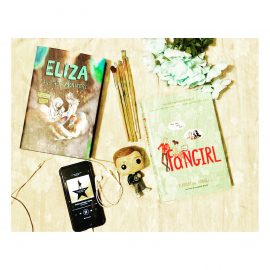This is a poem that I wrote for my English 4 class in 12th grade. It is a “Where I’m From” poem based on one by George Ella Lyon. Continue reading Where I’m From Poem
Category: Portfolio
Self Reflection
In this post, I am going to be reflecting on the 8 categories in my portfolio and how I have improved this year. Continue reading Self Reflection
Reflective Essay
This year in English has really helped me to grow in the areas of reading, writing, thinking, and speaking. I will be talking about reading, writing, and speaking. My skills have improved on major scales, and I’ve enjoyed this class more than I thought I would. Many pieces helped me to grow in these areas, but in this essay, I’m going to talk about specific projects that helped me grow in these four areas. Continue reading Reflective Essay
Whole Year Progress
Throughout this year, I have grown a lot in the areas of reading writing, communication, and thinking. At the beginning of the year, all I really wanted to do was get better at writing. Now, at the end of the year, I know that my writing has, in fact, improved, and I want to go into a job involving writing. Continue reading Whole Year Progress
Portfolio Explanation
This is my final portfolio for my sophomore English class. It has pieces of writing in 8 categories. Continue reading Portfolio Explanation
English Study Guide
Here is a Study Guide I made for my English final, for anyone who wants to look at it to see what we learned throughout the year. Continue reading English Study Guide
Informative Speech Outline
Intro
Hi, I’m Paige Trutna, and I’m going to be talking about photography. To start today, I have a question for you. Have you ever been looking through your old pictures or your camera roll and all of a sudden, you come across one specific picture that brings back hundreds of memories? That’s what photography can do. You may be thinking “why am I learning about this? What if I don’t want to be a photographer?” (gesture) and maybe, you don’t want to get seriously into photography, but everyone takes pictures, even on their phones. So I can guarantee, even if not all of my speech applies to you, at least some of it will. I can teach you about the many aspects of photography that you can use in your everyday life, even if you’re not a serious photographer. Continue reading Informative Speech Outline
Adversity Reflection
Throughout this adversity unit, I’ve learned a lot about the struggles that other people can go through that I might not know about. Especially with Eleanor and Park, I learned that many things can be happening in other’s lives. We must pay attention to other people to possibly know what they are going through, then we need to help them get through their struggles. We should show the love of God through our actions towards others. Galatians 6:2 states “Carry each other’s burdens, and in this way you will fulfill the law of Christ.” Adversity can also be very hard to escape for some people. They may experience it at home as well as at school, so we need to be there for them if that could possibly be the case, even if other people don’t like us for it. We also need to remember to tell others about adversity we are facing ourselves. We can’t be isolated from society, like Eleanor was. She didn’t really tell anyone about her struggles, which resulted in them only getting worse. If she would’ve told people earlier, possibly she could’ve faced Richie and her mother with the help of people like Park, Beebi, and Denice. We also need to realize that while adversity can be big or small, it effects everyone. While I am not going through any super major adversities in my life, there are still struggles that I have to face every day. Others, however, may face larger adversities, such as Eleanor in the book. However, these adversities can effect everyone in virtually big ways. It could be one major adversity or struggle that someone is going through in their life, or it could be many large struggles that add up to make someone snap. We need to be there for people through these adversities.
Disposability Essay Final Draft
Paige Trutna
Mrs. Jank
English 2
9 February 2018
The Supposed Disposability of the Disabled
In society today, many people with disabilities are seen as disposable. The mentally and physically disabled are seen as easy to throw away because of many things. Bishop John Wester states that “to overcome a throwaway culture, every person must go out into the world, encounter other people as more than commodities, and learn to treat everyone with the dignity they deserve” (Pope Francis and the Disposable Garment). Those with disabilities, especially children, are more likely to have chronic depression and be victimized by people in their lives. Women are more likely to be victims of IPV, or Intimate Partner Violence. Their supposed disposability also has an effect on the people around them; particularly parents of children with disabilities are more subject to anxiety. There are also many stories and current events that help us understand how the disabled are seen as disposable and how society can stop it. While there are many ways that people with disabilities are seen as disposable by society, there is also a side to the argument that could argue that society does not see them as disposable, because a benefit that the disabled have is health care, which allows for financial help.
The first way that the disabled can be seen as disposable by society is because depression and victimization are increasingly common in disabled children. They know that the American society often sees them as useless, so they are more prone to being depressed because of it. The Children’s Depression Inventory states that “9% of CWS (child welfare system) involved youth reported depression” (Berg 41). Depression is defined as “feelings of severe despondency and dejection.” One would argue that the key word in this definition is “severe.” Chronic depression in disabled children is not something that is just no big deal, nor should it be seen that way.
While depression is not something that should be seen as easily surmountable or minor, neither are victimizations. These victimizations are incredibly common in children with disabilities, and shows how they are, in fact, seen as disposable. The National Survey of Child and Adolescent Wellbeing proves this, saying that “24.3 percent [of children] reported one victimization, 15% reported 2, and 21.3% reported three or more victimizations” (Berg 41). These are the respective percentages of disabled children who have been abused, whether it be by an acquaintance, relative, or complete stranger. It is important to take into account that over 1/5 of disabled children in the United States have been abused three or more times. They are seen as easier to dispose of and hurt than normal children.
While depression is common in children with disabilities, anxiety is highly likely in parents of children with disabilities. This shows how people with disabilities are seen as disposable because their parents are worried about their welfare. An article by Omar A Al-Farsi, Yahya M Al-Farsi, and Samir Al-Adawi shows one that “from existing literature, it appears that psychological disorders of 15%–54% of CASD (caregivers of children with autism spectrum disorder) may be marked with symptoms of anxiety” (3). Keep in mind, this is only for parents of children with autism, but it is important to know. If these are the stats for one disability, then what do the stats look like in general? Well, “45.9% of caregivers reported for having stress and anxiety, while 48.6% reported having depression” (13-14). If society did not see disabled children as disposable, perhaps stress and anxiety of parents would not be as major of a problem. In the American society, disabled children are portrayed negatively, so parents could potentially be worried about their children being abused or made fun of at school, invoking that stress and anxiety, which can be avoided.
While feelings of depression and anxiety can potentially be avoided, so can intimate partner violence, one of the most major abuses a woman can take in her lifetime. This is also common in women with disabilities, which can just point back to how they are seen as disposable by the American society. In an article by Karen G. Langer, she states that “Violence against women has been acknowledged by the World Health Organization as a worldwide epidemic” (114). Violence against women in general has become a major problem in society, so violence against disabled women is also becoming more and more of a problem. According to the NIJ (National Institute of Justice), “approximately 25% of women endure Intimate Partner Violence during their lives” (115). This stat is for women all together, but from previous information, one can assume that the stat for disabled women, who find it harder to defend themselves, will be much higher. This article also came up with a list of reasons why disabled women could be more prone to violence. These included “increased vulnerability for abuse as increased dependability on others, violation and denial of human rights, less chance of discovery or reporting this abuse, social isolation, and increased risk of manipulation” (115-116).
Just like Intimate Partner Violence is a major problem within society, especially when it is directed toward disabled women, victimization of people with disabilities in general can be a problem. Lynda Jones, a woman with blindness, has spoken out on this issue and told her story. Jones was walking home from an internship one day in the afternoon, and she heard someone running behind her. She was confused because it was overwhelmingly hot that day, and didn’t understand why anyone would be running. However, she didn’t think much of it and continued walking home. She turned a corner and felt the runner right next to her, and she said that “in a matter of moments, I heard the jogger coming up on my right side. My first thought was perhaps I was not walking along the edge of the street. Never once did I feel endangered” (Jones, Vision Aware). However, she then felt a pulling on her purse and realized that the jogger was stealing from her. She yelled for help, and a man and his son that were watching from their apartment window came to her aid. Now, Lynda Jones leads a self defense class for the blind to ensure that no one else will have to go through what she went through. Her story just points back to how supposed disposability of disabled people is a problem in society. She was immediately targeted because she was blind, which would be much less likely to happen to someone without disabilities.
Just like Lynda Jones has spoken out about her supposed disposability, others have shared their stories about just how cruel society can be, including Nathalie Allport-Grantham and Euan McGlip. Nathalie is a woman with invisible disabilities, which, as is probably obvious, means one cannot see them. She was refused help at an airport because of her disabilities. The woman who was supposed to assist her didn’t believe she was disabled, so she was forced to pay for aid. When asked what happened, Allport-Grantham said “then she said loudly, in earshot of everyone at the gate: ‘I’ve got disabled people to help and you are wasting their time’. Everyone was staring. It was humiliating” (The Independent). Euan McGlip also shared his story. He revealed that he and his family were refused help at an Air Canada airport, even though they had a disabled son. They were forced to pay more than they should have because of mistreatment by the airport. “We explained that we had a doubly incontinent disabled child with us and that, at Air Canada’s original instruction, we only had enough sanitary and medical products to last him the expected flight plus a few hours. According to staff, this was ‘not their problem’” (McGlip). Both Nathalie and Euan show examples of how disabled people and their families are often seen as disposable or useless by society because of how people treat them. Even though they are clearly disabled and need help, people refuse to help them because of their struggles.
While the majority of arguments are that disabled people are often seen as disposable by American society, there are some things that prove that they do have help possible. Both the Social Security and Supplemental Security Income programs have financial aid for people with disabilities, along with many help programs across the country. The Social Security system gives financial benefit to disabled people with insurance. “Social Security Disability Insurance pays benefits to you and certain members of your family if you are “insured,” meaning that you worked long enough and paid Social Security taxes” (Benefits for People with Disabilities). The Supplemental Security Income system also helps with financial aid. If desperately needed, the SSI will give the disabled person and/or their family money, depending on how much is needed. Both of these programs argue against the supposed disposability of disabled people.
In conclusion, people with disabilities are mostly seen as disposable by the American society today. This can be seen in depression and victimization in children with disabilities. Children with disabilities are worried about what people think of them, so they are more prone to feelings like this. Anxiety in parents with disabled children is also common. They are concerned about how their children are being treated, especially at school, invoking these feelings. Women also have an increased risk of IPV, because of their increased vulnerability. There are also stories about different people who have shared about their disabilities, which proves that disabled people are more likely to be seen as disposable by society. However, one can argue that disabled people do have help spread across the country, especially in the Social Security and Supplemental Security Income systems. All of these points are reasons that disabled people are seen as disposable by society.
Works Cited
Berg, K. L.; Shiu, C.-S.; Msall, M. E.; Acharya, K. Child: Care, Health & Development. Nov2015, Vol. 41 Issue 6, p989-999. http://search.ebscohost.com/ login.aspx?direct=true&db=cmh&AN=111382444
Julia Buckley. “Disabled woman “humiliated” by Airport Employee who Refused Assistance.” The Independent. 2 January 2018.
http://www.independent.co.uk/travel/news-and-advice/disabled-woman-stansted- airport-refuse-help-ryanair-nathalie-allport-grantham-a8138051.html
Carman, Linda. Perspectives in Psychiatric Care. May2006, Vol. 42 Issue 2, p114-129. 16p. http://search.ebscohost.com/login.aspx. direct=true&db=cmh&AN=20466176
Lynda Jones. Vision Aware. ND. http://www.visionaware.org/info/emotional-support/ personal-stories/crime-and-domestic-violence-stories/violent-crime-against- people-who-are-blind/1235
Langer, Karen G. “Depression and Denial in Psychotherapy of Persons with Disabilities.” American Journal of Psychotherapy, vol. 48, no. 2, Spring1994, p. 181. EBSCOhost, http://search.ebscohost.com/login.aspx? direct=true&db=f6h&AN=9411171210
Social Security website. ND. NA. https://www.ssa.gov/disability/
Neuropsychiatr Dis Treat. 2016; 12: 1943–1951. Published online 2016 Aug 4. doi: 10.2147/NDT.S107103. https://pwww.ncbi.nlm.nih.gov/pmc/articles/ PMC4977076/
Choice Reading Final Reaction
For my choice reading in English, I finished The Sun is Also a Star and am close to halfway through Clockwork Angel. In this reaction, I’m going to mostly be talking about The Sun is Also a Star, because I finished that one.
This book is one of my favorite books that I’ve read in a while. It was a really cute story that wasn’t cliche, like you’d maybe expect from a YA Contemporary Romance novel, but it was different and new. The characters were very diverse, which I feel like is important in the world today. Represented in this book was a Korean-American boy and a Jamaican-American girl.
When I picked up this book, I knew it was a romance, but I didn’t expect it to be so well put-together. Before reading The Sun is Also a Star, I had read another book by Nicola Yoon, which was also very good, but I liked this one better. The writing style was amazing, and the romance in this book was well-written, not cheesy, but also very enjoyable.
Along with the well-written romance, there were other aspects that allowed me to enjoy the book. We got to see the characters trouble with their families. Daniel didn’t get along with his brother at all, and we saw that come into the plot line with the romance when Charlie (his brother) made fun of Natasha and was being very racist. We also saw Natasha blaming her dad for what they had become and the fact that they were close to being deported.
I would recommend this book to anyone who likes to read. A forewarning: it has some language, but if you can ignore that, then the book is great. If you like romance or just a good read, this book is for you.





